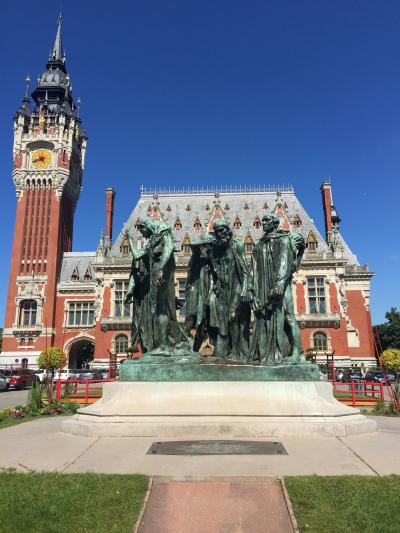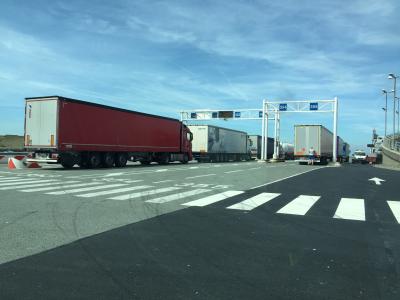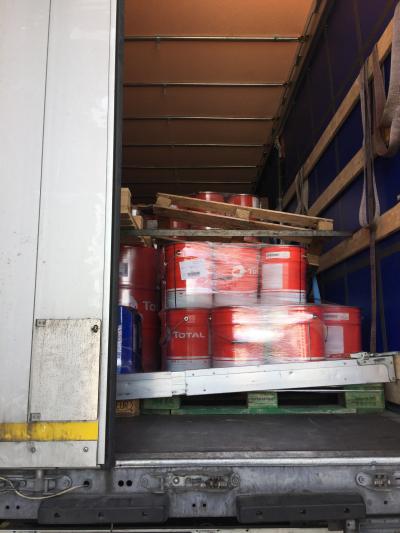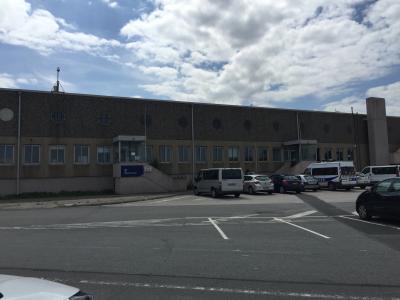Post by Mary Bosworth, Director of Border Criminologies, Follow Mary on Twitter, @MFBosworth.
In early July, I had the opportunity to visit the sites of juxtaposed control in Calais as a guest of HMIP, who were there, with their French counterparts, CGLPL, to conduct the first unannounced visits of the short term detention facilities in Calais, Coquelles, and Dunkirk since 2012 and 2014 respectively. This part of Northern France is both the edge of the Schengen Zone, and a site of the ‘juxtaposed controls’ set out by the 1991 Sangatte Protocol, the 2003 Treaty of Touquet, and various additional protocols and amendments such as that signed in 2011 allowing French law enforcement to carry service weapons on British soil. Such international legal arrangements penetrate deeply into the lives of local residents and those who wish to depart. Since Brexit, and for some time before, there have been increasing calls to end the juxtaposed controls, with the view to passing over its consequences to Britain: the notorious Calais camp and its thousands of residents.
Under the terms of the juxtaposed controls, Britain operates a series of small short-term detention sites within the Calais and Dunkirk ports and in the Eurotunnel area known as Coquelles. The French run a series of parallel short-term holding centres as well as a larger Centre de Retention Administrative, just outside the Eurotunnel area in Coquelles.
The British sites, as they would be in the UK, are contracted out to two private companies: Tascor in Calais and Coquelles, and Eamus Cork Solutions (ECS) in Dunkirk. Britain also employs a large complement of UK Border Force in these sites, a small contracted-out security force staffed by ECS and Wagtail, a sniffer dog company, and a group of Kent police officers. The British nationals among them commute from the UK to work long shift patterns, staying in a local hotel before returning home. Finally, the French are present too, in the numerous figures of the Polices Aux Frontières (PAF).

Despite having driven through Calais many times, I had never seen the camp before, as it is not in the direction that travellers to Paris or the South would usually follow. In fact, it is very close to the Ferry port, just a few kilometers up the road, surrounded on all sides by hundreds of meters of fencing. The hard shoulder of the highway by the camp and the port, and stretching up to Dunkirk, is dotted with the white vans of the PAF, and the national police as well. Occasionally, particularly close to the port, they disgorge groups of migrant men who have been found in the freight trucks, or who have walked too close to the fences.

In the town itself, pairs and sometimes trios of men walk and talk, sit in the sun, rest in the park, seemingly ignored by the townsfolk around them. At the least in the afternoon I was there, no police were in sight.Calais itself, like many British seaside areas, has fallen on hard times. Many of the local shops are closed and boarded up. Those that are open don’t sell much. It hasn’t been a particularly affluent area for many years, but the ‘problem’ at the border no doubt stifles tourism, despite the best efforts and enthusiasm of employees of the extensive local tourist office. As the fences multiply, and the numbers of police grow, Calais feels hemmed in. Designed to prevent the movement of irregular migrants to the UK, the visible architecture of security intrudes into everyday life. It is no wonder then, that this part of France has spearheaded much of the rise of the far-right Front Nationale.
Visiting Calais was disconcerting. Seeing border control at close proximity is always difficult. Some of it I am used to from years of observations and interviews in detention. But the stories were different, no longer accounts from people trying to stay, but stories of the lengths they go to in an attempt to depart. When I interview women and men in detention, they are usually unwilling to discuss in much detail this part of their experience, although I have, over the years, been told about the pains of Calais, the risks of getting onto lorries or hiding beneath them, the terror of irregular migration.
What I began to understand on this trip is that there are a series of different systems and processes at work in Calais depending on where people are discovered in the juxtaposed control area. Car passengers whose documents are not in order are handed to the British authorities for a period of detention while the UK Border Force investigate, whereas those discovered hiding in trucks are often simply shown off the premises by the French border police. Legal checks, let alone protections, for victims of trafficking, unaccompanied minors or refugees seem limited.

Hundreds of vehicles pass through the ports throughout the day. Despite attempts to search them all, it is clear that it is an impossible goal. Whole families are found hidden in boxes, ranging across multiple generations. Groups of young men interspersed with pallets of machine oil, found by sniffer dogs, others discovered when they knock to be let out of a refrigerated lorry, unable to bear the cold. The terminology in this border site is distinctly dehumanising: people are ‘clandestines’ and ‘illegals’, the moment of their discovery, a ‘find’. Individuals with false passports are ‘lookalikes’, while those banned from entry due to a criminal conviction, are ‘known’ in either country.

Under juxtaposed controls, the French and the British are permitted to operate border controls in a defined geographical space outside of their territory. It is not just symbolic, there is a little bit of the UK in Calais operating on British time. You enter the door and step back one hour, upon exiting, you are propelled an hour ahead. The phone numbers are British too, calling elsewhere in France requires the international area code. Like the staff, the ready meals and snack food are brought over from the UK. Unlike Immigration Removal Centres (IRCs), these sites of detention do not resemble prisons. With the exception of the detention unit in Coquelles Freight, earmarked for closure years ago, yet somehow still operational, they are not cellular. They are also not marked out by additional barbed wire or other signs of security. Instead they are built into the border zone itself, small clusters of buildings alongside passport control. Inside, they vary in appearance. Dunkirk and Calais tourist look like a police lock-up. Coquelles tourist appears more like an NHS waiting room.

Stripped of the confusing veneer of punishment, these are more evidently sites of administrative power. And yet, the criminal justice system is not entirely absent either. The French border police (PAF) are ubiquitous, set the task of removing individuals from this parcel of British territory, as well as engaging in border checks of their own. Sometimes, the PAF transport people out of the border zone to the local police and then the criminal court in Coquelles. Other times they take them straight to the CRA. In Dunkirk, the PAF operates a small holding cell, above the British one for individuals found in the freight trucks. From there, or from the British sites, they often simply deposit people at a transportation hub like a local bus stop, or the ferry terminal building, as banned by the UK, they are allowed to remain in French territory. On occasion the PAF deliver people to the Camp.
The mix of jurisdictions in these sites, and personnel, and nationalities, is both difficult to describe concisely and confounds easy understanding. Notwithstanding claims in the academic literature about the universality of borders and their transportability, in the bodies of those subject to immigration control, the frontier feels different. The syncopation of ‘finds’ and the ongoing movement of bodies through detention and out again, gives these sites a particular mobility of their own. The complicated legal arrangements and intersecting forms of governance are simultaneously restrictive and expansive. Meanwhile, the humanity of the people being found, detained and expelled generates a particular urgency and horror that is only partially contained by the bureaucracy and banality of immigration control processes.
While researchers and activists and charities have paid considerable attention to the Camp at Calais, and rather less to the one outside Dunkirk, as yet, we have no applied academic study of these official sites of detention. In that, they join the other Short-term holding facilities (STHFs) throughout the UK, which also remain under-examined. I wonder whether academics are not as interested in STHFs as they might be.
My observations in Calais and Dunkirk reaffirmed my view that I need to spend more time theorizing administrative power, while also identifying other matters to investigate. For as long as people hide themselves and their children in lorries, work needs to be done. Meanwhile, the HMIP and CGPL joint report on these sites of confinement will be available in around three months time.
Any comments about this post? Get in touch with us! Send us an email, or post a comment here or on Facebook. You can also tweet us.
__________
How to cite this blog post (Harvard style):
Bosworth, M. (2016) British Border Control on the French North Coast. Available at: https://www.law.ox.ac.uk/research-subject-groups/centre-criminology/centreborder-criminologies/blog/2016/07/british-border (Accessed [date]).
Share:








